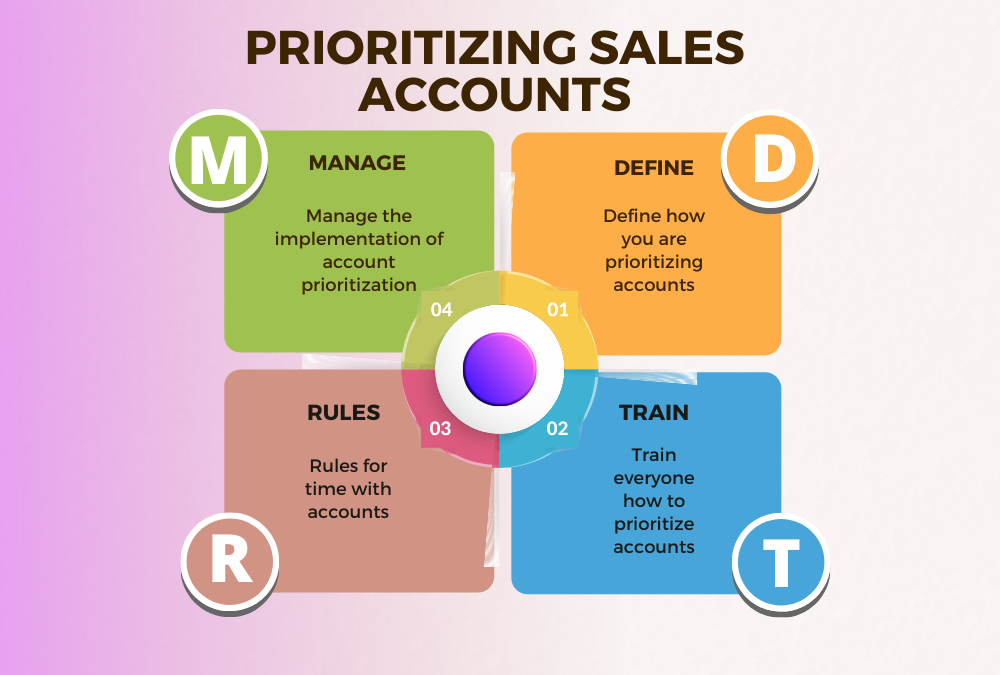Question:
I’ve heard you mention several times the importance of prioritizing and targeting customers. Can you shed some more light on this?
Answer:
Prioritizing accounts is a key issue for me, as I believe it is one of the ways to make the biggest, most rapid change in your results. Too much good quality sales time and talent are squandered on customers who aren’t worth the investment. If I can help salespeople adjust their investment in time so that they are spending more time on the high potential and less time on others, they’ll see an almost immediate improvement in results.
So, over years of trial and error, I have developed a simple but incredibly powerful system for prioritizing and targeting accounts. While I don’t have space here to describe the whole system, I can suggest several things you can do to institute this practice in your sales team’s routines.
First, you’ll need to make sure everyone understands the difference between ‘potential’ and ‘history.’ Too many sales teams prioritize their time on the basis of history. In other words, “A” accounts are those who spent the most last year. In today’s rapidly changing economy, I don’t think it’s wise to make decisions based on the past. A more powerful and useful concept is to make decisions based on the future. So, a high-potential account is one that could buy the most next year, not one that did last year.
1. Define How You Are Prioritizing Accounts
Set up some company-wide definitions. Everyone should understand what an “A” account is. Likewise for B and C accounts. In addition, there ought to be some standards for how you define each of these. For example, you might say an A account is one that could buy $1,000,000 of your stuff each year. OK, how do you determine that an account could buy $1,000,000? Does the salesperson guess? Or do you use some more sophisticated means of coming to that number?
In our system, we account for two variables within each customer. First, what is the QPC of each account? QPC stands for Quantified Purchasing Capacity, and is the answer to this question: If this account bought everything they could from me in the next 12 months, how much would that be?
After having worked, personally and contractually with over 329 individual companies, I am continually amazed at how few (less than a handful) actually collect that information. Doesn’t it seem like an elementary thing that every salesperson should be collecting?
The second variable is “partnerability” which is the measurement of a number of subjective variables, all having to do with the likelihood that this account will develop into a significant, committed customer sometime in the future.
With those two variables in hand, we can rank every prospect and every customer by their potential. Addressing these issues is the first step, and can often set off light bulbs in the salesperson’s heads all by themselves.
2. Train Everyone How to Prioritize Accounts
Once you’ve created the criteria and definitions, train the entire group in the use of those concepts. Require that, by a certain date, they have analyzed and rated all of their customers. You may even develop some forms, electronic or hard copy, which everyone uses.
This process can also be an eye-opener all by itself. When you help salespeople analyze the potential in their accounts, and then examine their accounts from that perspective, you (and they) will be amazed at how much time is spent on accounts that just aren’t worth it.
3. Rules for Time With Accounts
Now, legislate that everyone should spend the biggest portion of their time with the A accounts. My rule is 50% of your time with the A accounts and 50% of your time with everyone else.
4. Manage the Implementation of Account Prioritization
Manage the implementation. Every time you ride with a salesperson, discuss it and look for evidence that indicates the salesperson is following through on using the system. Make it an issue in sales meetings and in evaluations.
When salespeople actually spent more time in those priority accounts with greater potential and less time in those with little potential, they discover a dramatic improvement in their productivity.
I have developed a variety of resources to help you with this. The system is described in detail in Chapter Six of my book, 11 Secrets of Time Management for Salespeople.
If you are selling remotely more than ever before, then you know that the medium demands a more prepared, focused, and intentional sales call. Your salespeople can’t just show up! They must think about it before they do it. Fortunately, that’s a mantra from STRETCH – The Strategic Time Management Course for Salespeople and one of the fundamentals we teach with proven processes, practices, and tools.
The reason I have so much material on this subject is that I believe that it is one of the key behaviors for sales success. Everyone should be using it.
****************************************************************************************
“The quickest way to improve a sales team’s productivity is to improve their time management.” ~ Dave Kahle
Let us teach them how. In 15 minutes a week, for the price of a nice lunch.
Learn more here.
Other people can teach you to sell. We empower you to sell better!


Trackbacks/Pingbacks